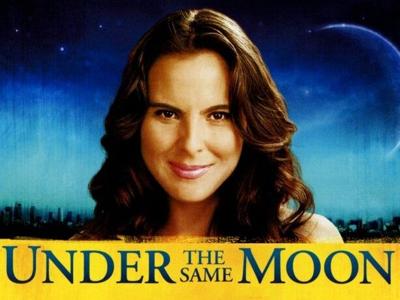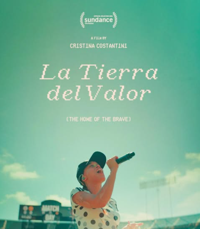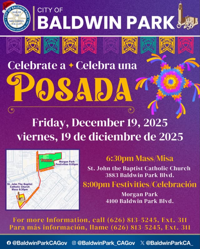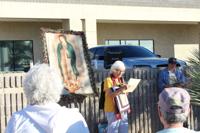
For almost a century, artists, writers and filmmakers from the Latino community have been documenting and dissecting the immigration experience in the United States. Their work not only challenges dominant narratives but also provides historical context and deep cultural insight that remains critical to understanding today’s immigration policies, debates and community resilience.
As immigration enforcement tactics—like raids, detentions, and deportations—continue to change and reshape the city of Los Angeles and the state of California, many are turning to books, documentaries and narrative films to better understand the roots of these policies and the people impacted by them and also find a space to reflect, heal and be seen.
Whether a newcomer to the conversation or someone seeking to go deeper, the following works serve as a starting point for learning about immigration through Latino perspectives:
Documentaries
Directed by immigrant filmmaker Dario Guerrero, this intimate documentary tells the story of a mother’s cancer diagnosis and a son’s love. After Guerrero’s mother, Rocio, is denied treatment in the U.S. due to her undocumented status, the family returns to Mexico. What follows is not a story of defeat, but of familial care, cultural reconnection and strength in the face of bureaucratic violence.
Directed by Cristina Ibarra and Alex Rivera, this hybrid documentary-fiction film follows undocumented youth activists who deliberately get detained by ICE to expose the conditions inside. Based on true events, it celebrates the boldness and brilliance of immigrant organizers, showcasing the sacrifices and stories people still don’t know about. Ibarra and Rivera’s filmmaking rejects pity and embraces strategy and resistance.
Directed by Peter Bratt and executive produced by Carlos Santana, this documentary tells the story of Dolores Huerta, longtime labor activist and co-founder of the United Farm Workers. The film centers a Mexican American woman’s organizing legacy, not as an act of victimhood, but as one of visionary power and collective action. It reminds viewers that immigration and labor rights are deeply intertwined.
"Immigration Nation" (Netflix, 2020)
Even though they aren’t Latino, filmmakers Shaul Schwarz and Christina Clusiau were granted rare access to ICE agents and operations during the Trump administration, exposing what would become an escalated strategy of ICE enforcement. The docuseries examines the internal dynamics of immigration enforcement while juxtaposing those practices with the stories of immigrant families, attorneys and organizers. It is a shocking look at the machinery of detention and deportation in modern America.
Based on the book by journalist Juan González, this film investigates the root causes of Latin American migration to the U.S., emphasizing the role of U.S. foreign policy in destabilizing countries such as Guatemala, El Salvador and Nicaragua. By situating migration in a geopolitical context, it challenges the notion that immigration is solely a domestic issue and also truly showcases how migration and immigration is in flux with U.S. intervention.
"Uvalde: 365" (2023)
While not exclusively about immigration, this ABC News Studios and Hulu series documents the aftermath of the Uvalde school shooting, which took place in a largely Latino community. One standout episode centers on a mother who is undocumented and must navigate her trauma while avoiding public scrutiny for fear of ICE. The series underscores the intersections of immigration status, race, and community vulnerability and how being an immigrant can place you at more risk.
Feature films
"Under the Same Moon" (La Misma Luna, 2007)
This iconic-nostalgic drama, directed by Patricia Riggen, focuses on a young Mexican boy who travels to the U.S. to reunite with his mother after the death of his grandmother. The story offers a family-friendly but emotional perspective on separation due to immigration policies and the strength of transnational familial bonds.
Gregory Nava’s seminal film before making “Selena” (1997) follows two Indigenous Guatemalan siblings fleeing political violence and attempting to build a life in Los Angeles. Shot across Guatemala, Mexico and the U.S., the film portrays both the push factors of migration (that is mentioned in “Harvest of Empire”) and the exploitative conditions migrants face once they arrive. “El Norte” was one of the first major films to humanize undocumented immigrants on screen and continues to be one of the most important narrative films around immigration.
“Minari” (2020)
Though not centered on Latino immigration, “Minari” (2020), directed by Lee Isaac Chung, is an essential film in the broader canon of American immigrant storytelling. The film follows a Korean American family as they relocate to rural Arkansas in pursuit of economic independence and a better future. What makes “Minari” resonate across immigrant communities is its quiet, nuanced portrayal of resilience, intergenerational conflict and the tension between assimilation and cultural preservation. Rather than focusing on trauma or external threats, the film emphasizes dignity, labor and love within the family unit—offering a deeply relatable narrative for many immigrant viewers, including Latinos, who see parallels in their own stories of sacrifice and survival.
BOOKS
"Solito" by Javier Zamora (2022)
While Zamora’s memoir recounts his journey as a child migrating alone from El Salvador to the U.S., it goes beyond survival. His prose captures the intimacyof memory and the imagination of a child who dreams even while crossing literal deserts. His poetic background infuses the narrative with tenderness and futurity—healing the past through voice.
"Cruel Futures" by Carmen Giménez Smith (2018)
This poetry collection by the Bolivian American writer is a sharp, satirical and emotionally complex meditation on identity, gender, family and nationhood. Giménez Smith challenges colonial constructs and capitalist systems while offering surreal, borderless visions of selfhood and resistance. Her work invites readers to question the very framework of citizenship and belonging.
"Citizen Illegal" by José Olivarez (2018)
In his groundbreaking debut poetry collection, Olivarez—son of Mexican immigrants—writes about growing up in Chicago, navigating two languages, and rejecting the binary of “legal” versus “illegal.” With humor and insight, the poems celebrate joy, cultural inheritance and everyday life while dismantling the rhetoric of exclusion. Olivarez writes immigrants into the future with clarity and grace.
"Dreaming of You" by Melissa Lozada-Oliva (2021)
This experimental novel-in-verse imagines a bruja who resurrects Tejano pop star Selena and grapples with the aftermath. Blending horror, pop culture and immigrant girlhood, Lozada-Oliva’s work explores themes of Latinidad, desire and diasporic longing with sharp wit and speculative flair. It’s a feminist reimagining of borderlands culture that doesn’t seek validation, only reinvention.
"Return to My Native Land" (Cahier d’un retour au pays natal) by Aimé Césaire (1956, various translations)
Rooted in the Caribbean experience, this long-form poem by Martinican writer Aimé Césaire remains a foundational text for any exploration of colonial displacement, exile and spiritual return. His language breaks linear time and geography, offering a decolonial imagination that resonates with immigrant futurisms across diasporas.
"The Magic of We" by Andrés Cerpa (2023)
In this luminous collection, Puerto Rican poet Andrés Cerpa blends love, memory and grief with cosmic imagery and expansive tenderness. Though not centered exclusively on immigration, Cerpa’s poems reflect diasporic dislocation and ancestral healing, offering a vision of wholeness amid fragmentation.
"Reinas" by Melissa Coss Aquino (2024)
Set in the Bronx with deep ties to Puerto Rican identity, this novel imagines matriarchal lineages, Afro-Caribbean spirituality and feminist agency through the lens of migration. Aquino’s storytelling is visionary, blending myth, community and the body as a site of survival and transformation. It’s an anthem for those who imagine life beyond inherited trauma.
Additional resources
Organizations like the Futuro Media, the Latino Media Collective, United We Dream and Define American also offer curated storytelling series, webinars and media campaigns focused on immigrant experiences. Podcasts such as Latino USA, Radio Ambulante, and PRESENTE (produced by CALÓ News) provide rich reporting and narratives directly from impacted communities.
Why storytelling matters
Media created by immigrants and for Latino communities offers a powerful counterbalance to mainstream coverage that often reduces immigration to a set of videos of raids, numbers or policies. These books, films and documentaries illuminate the emotional, cultural and historical stakes of migration, providing tools for both imagination, healing, education and empathy.
In revisiting the past 40 to 50 years of Latino storytelling about immigration, a consistent message emerges: immigration is not a new crisis and its story is being told now by immigrants themselves. It is a continuous struggle shaped by history, economics and survival. These works remind viewers and readers that the U.S. has been here before—and that communities have long been documenting the journey.











(0) comments
Welcome to the discussion.
Log In
Keep it Clean. Please avoid obscene, vulgar, lewd, racist or sexually-oriented language.
PLEASE TURN OFF YOUR CAPS LOCK.
Don't Threaten. Threats of harming another person will not be tolerated.
Be Truthful. Don't knowingly lie about anyone or anything.
Be Nice. No racism, sexism or any sort of -ism that is degrading to another person.
Be Proactive. Use the 'Report' link on each comment to let us know of abusive posts.
Share with Us. We'd love to hear eyewitness accounts, the history behind an article.